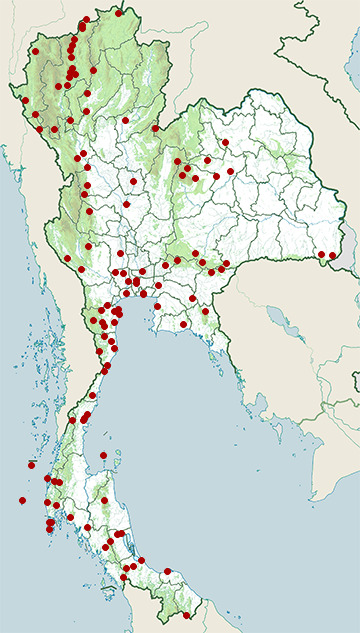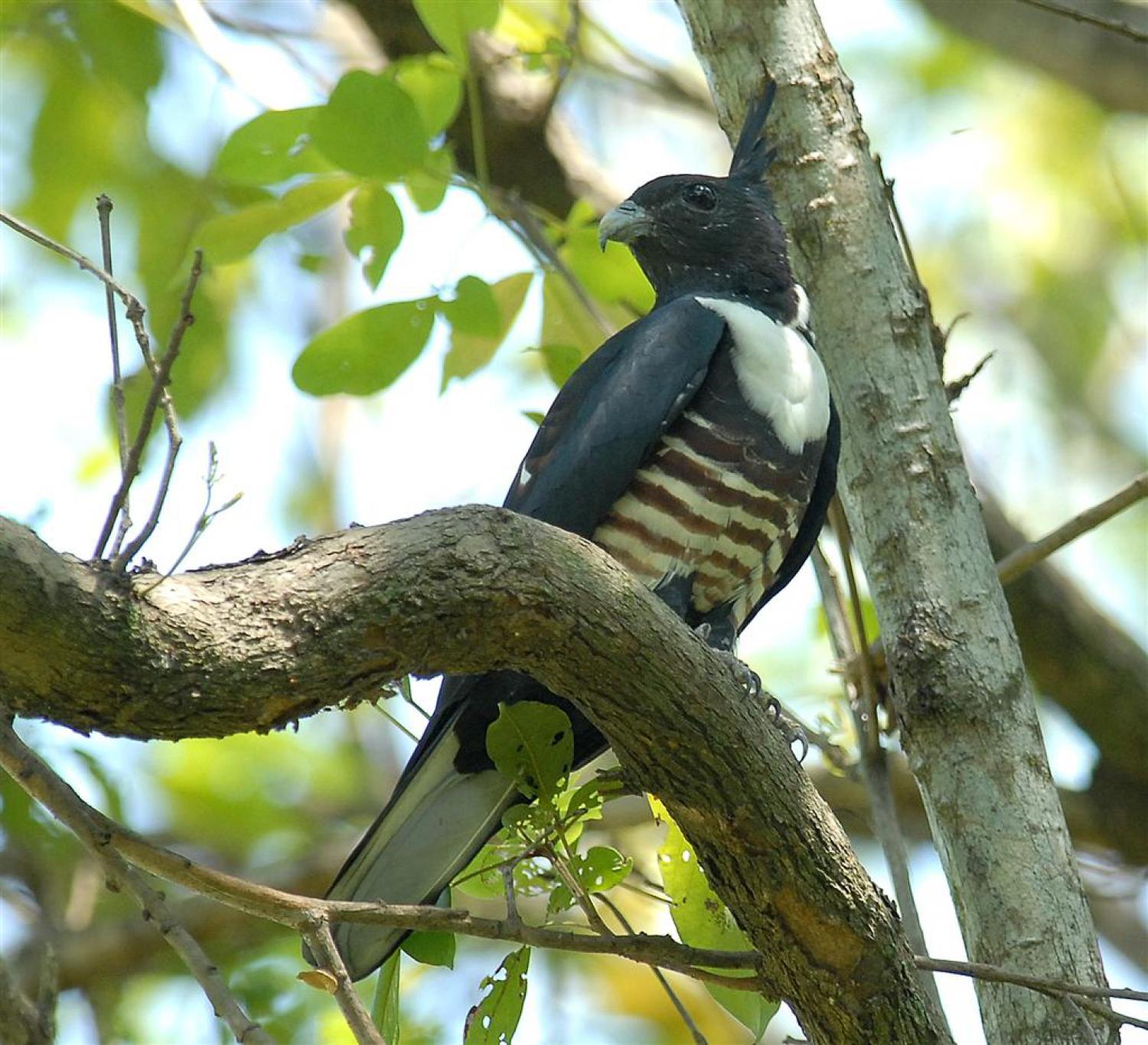Species of Thailand
Black baza
Aviceda leuphotes
Charles Dumont de Sainte-Croix, 1820
In Thai: เหยี่ยวกิ้งก่าสีดำ
The black baza (Aviceda leuphotes) is a small sized bird of prey found in the forests of the Northeast India, the eastern Himalayas, China and Southeast Asia. Many populations are migratory. The races in the Indian region are migratory, wintering in the south of the Peninsula and Sri Lanka. The black bazas have short, stout legs and feet with strong talons. A prominent crest is a feature of the bazas. They are found in dense forest often in small groups. They are also known to spend a lot of time perching on bare branches of tall trees rising above the forest canopy.
Taxonomy and systematics
The bird was first described based on a specimen from Pondicherry under the name of Falco leuphotes. Several geographic races have been described including wolfei which is based on a single specimen from Sichuan and may belong to the nominate subspecies. The named forms include the following, but they have been questioned and further study has been called for.
- A. l. syama (Hodgson, 1837) from eastern Nepal, northeastern India to south China which winters in Indo-China and the Malaya Peninsula.
- A. l. leuphotes (Dumont, 1820) was once claimed to breed in South-Western India, but no evidence exists and this is doubtful. It is said to breed in Burma and Thailand, in which case it would likely be the same as syama, although the population in this region has in the past been assigned the name of burmana.
- A. l. andamanica (Abdulali & Grubh, 1970) is endemic to the Andaman Islands (South Andaman I) and has completely white underparts lacking any chestnut bands.
Description
The black baza is a small and distinctively coloured raptor; it ranges from 30 to 35 cm in length, a 66 to 80 cm wingspan and a weight of 168 to 224 g. When perched, the upright crest and contrasting patterns make it difficult to misidentify. The male has white scapulars, secondary coverts and on the secondaries. The female has white only on the scapulars and more chestnut bands on the underside unlike the few bands in the male.
While flying, it is similar to a crow and is often seen in small groups or flocks during migration. During migration, they are gregarious at their roost. They are somewhat crepuscular and more active at dusk and in overcast weather.
They feed mainly on insects by making aerial sallies. They may also pick insects off a leaf, the insects always seized with their feet. They have been observed to attempt capturing small birds such as wagtails by making dashes into flocks. They have been noted to join mixed-species foraging flocks. It has also been known to feed on the fruits of the oil palm. They are somewhat crepuscular in habit. The call is a "chu-weep" somewhat similar to the call of the large cuckoo-shrike. Other descriptions include a soft squeal or whistle and a shrill gull-like mewing.
Like others in the genus Aviceda they have two tooth like indentations on the edge of the upper bill. Birds are said to have a disagreeable odour which has been said to be "bug-like".
Distribution
This species is found in Southeast Asia and parts of South Asia. They are migratory in parts of their range. Migratory birds may be seen in large numbers at some locations such as Chumphon in Thailand where they account for nearly 40% of the raptors on passage. In some parts of Hong Kong, they have established themselves in recent times changing from summer visitors to residents in small numbers.
In southern India the species is regularly reported in winter mainly from the Western Ghats (breeding records have been questioned), Eastern Ghats (mainly on spring passage) and known to breed in northeastern India and Burma. Winter records of the species include stray occurrences in or near metropolitan areas such as the Guindy National Park in Chennai, near Trivandrum
and Bangalore. More recent studies have suggested that the species may be a regular winter visitor in the eastern part of peninsular India, and not just a passage migrant. Individuals have also been noted at Point Calimere.
The birds in northeastern India begin to breed in April. Both sexes take part in nest building, incubation, brooding and feeding. The nest is a firm platform of thin sticks with a central depression and lined with grass, fiber and overlaid with green leaves. The eggs take about 26–27 days to hatch. Insects are the predominant food of the chicks.
This article uses material from Wikipedia released under the Creative Commons Attribution-Share-Alike Licence 3.0. Eventual photos shown in this page may or may not be from Wikipedia, please see the license details for photos in photo by-lines.
Category / Seasonal Status
BCST Category: Recorded in an apparently wild state within the last 50 years
BCST Seasonal statuses:
- Resident or presumed resident
- Non-breeding visitor
Scientific classification
- Kingdom
- Animalia
- Phylum
- Chordata
- Class
- Aves
- Order
- Accipitriformes
- Family
- Accipitridae
- Genus
- Aviceda
- Species
- Aviceda leuphotes
Common names
- Thai: เหยี่ยวกิ้งก่าสีดำ
Synonyms
- Falco leuphotes
Conservation status

Least Concern (IUCN3.1)
Photos
Please help us review the bird photos if wrong ones are used. We can be reached via our contact us page.
Range Map

- Ang Thong National Marine Park
- Bang Len District, Nakhon Pathom
- Bang Phra Non-Hunting Area
- Bang Pu Recreation Centre
- Bang Saphan Noi District, Prachuap Khiri Khan
- Bangkok Province
- Bueng Boraped Non-Hunting Area
- Chae Son National Park
- Chaloem Rattanakosin National Park
- Chiang Dao District, Chiang Mai
- Chiang Dao Wildlife Sanctuary
- Doi Chong National Park
- Doi Inthanon National Park
- Doi Lang
- Doi Lo District, Chiang Mai
- Doi Pha Hom Pok National Park
- Doi Suthep - Pui National Park
- Fang District, Chiang Mai
- Hala-Bala Wildlife Sanctuary
- Hang Chat District, Lampang
- Hat Wanakon National Park
- Hat Yai District, Songkhla
- Hua Hin District, Prachuap Khiri Khan
- Huai Kha Khaeng Wildlife Sanctuary
- Kaeng Krachan District, Phetchaburi
- Kaeng Krachan National Park
- Kamphaeng Saen District, Nakhon Pathom
- Kaset Sombun District, Chaiyaphum
- Khao Ang Rue Nai Wildlife Sanctuary
- Khao Banthat Wildlife Sanctuary
- Khao Dinsor (Chumphon Raptor Center)
- Khao Luang National Park
- Khao Nang Phanthurat Forest Park
- Khao Phra - Bang Khram Wildlife Sanctuary
- Khao Phra Thaeo Wildlife Sanctuary
- Khao Sam Roi Yot National Park
- Khao Sanam Prieng Wildlife Sanctuary
- Khao Soi Dao Wildlife Sanctuary
- Khao Sok National Park
- Khao Yai National Park
- Khao Yoi District, Phetchaburi
- Khlong Lan National Park
- Khlong Luang District, Pathum Thani
- Khon San District, Chaiyaphum
- Khuan Khanun District, Phatthalung
- Klaeng District, Rayong
- Ko Phra Thong
- Kui Buri National Park
- Laem Pak Bia
- Lan Sang National Park
- Mae Moei National Park
- Mae Ngao National Park
- Mae Ping National Park
- Mae Rim District, Chiang Mai
- Mae Taeng District, Chiang Mai
- Mae Wong National Park
- Mueang Chachoengsao District, Chachoengsao
- Mueang Chiang Mai District, Chiang Mai
- Mueang Chumphon District, Chumphon
- Mueang Khon Kaen District, Khon Kaen
- Mueang Krabi District, Krabi
- Mueang Nakhon Nayok District, Nakhon Nayok
- Mueang Nonthaburi District, Nonthaburi
- Mueang Pattani District, Pattani
- Mueang Phang Nga District, Phang Nga
- Mueang Phetchaburi District, Phetchaburi
- Mueang Phuket District, Phuket
- Mueang Prachuap Khiri Khan District, Prachuap Khiri Khan
- Mueang Samut Sakhon District, Samut Sakhon
- Mueang Songkhla District, Songkhla
- Mueang Suphanburi District, Suphan Buri
- Mueang Tak District, Tak
- Mueang Uttaradit District, Uttaradit
- Nam Nao National Park
- Nam Phong National Park
- Nam Yuen District, Ubon Ratchathani
- Namtok Mae Surin National Park
- Non Din Daeng District, Buriram
- Nong Bong Khai Non-Hunting Area
- Nong Ya Plong District, Phetchaburi
- Nong Yai Area Development Project Under Royal Init
- Omkoi Wildlife Sanctuary
- Op Khan National Park
- Pak Thale
- Pang Sida National Park
- Pha Daeng National Park
- Phu Chong Na Yoi National Park
- Phu Foi Lom National Park
- Phu Khiao Wildlife Sanctuary
- Phu Suan Sai National Park
- Phu Wiang National Park
- Phutthamonthon District, Nakhon Pathom
- Pran Buri District, Prachuap Khiri Khan
- Sai Yok District, Kanchanaburi
- Sai Yok National Park
- Sakaerat Environmental Research Station
- Salawin National Park
- Samut Prakan Province
- Similan Islands
- Sri Phang-nga National Park
- Surin Islands
- Ta Phraya National Park
- Taphan Hin District, Phichit
- Tha Yang District, Phetchaburi
- Thai Mueang District, Phang Nga
- Thalang District, Phuket
- Thale Ban National Park
- Thale Noi Non-Hunting Area
- Thap Lan National Park
- Ton Nga-Chang Wildlife Sanctuary
- Wang Mai Forest Restoration Project
- Yan Ta Khao District, Trang

